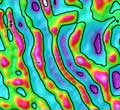 |
The Norway Basin and the Jan Mayen “microcontinent”: Insights from new high-resolution aeromagnetic surveys |
Laurent Gernigon1, Anett Blischke2, Aziz Nasuti1 and Morten Sand3
1Continental Shelf Geophysics, Geological Survey of Norway (NGU), Leiv Eirikssons vei 39, Trondheim, Norway, Laurent.Gernigon@ngu.no ; Aziz.nasuti@ngu.no
2Íslenskar Orkurannsóknir / Iceland GeoSurvey (ISOR), Department of Energy Technology, Rangarvellir, P.O. Box 30, 602 Akureyri, Iceland, anb@isor.is
3Norwegian Petroleum Directorate (NPD), Professor Olav Hanssens vei 10, P.O. Box 600, 4003 Stavanger, Norway, Morten.sand@npd.no
This webpage is a summary of: Gernigon, Laurent, Anett Blischke, Aziz Nasuti and Morten Sand, Conjugate volcanic rifted margins, seafloor spreading, and microcontinent: Insights from new high-resolution aeromagnetic surveys in the Norway Basin, Tectonics, 34, 907–933, Article first published online: 13 MAY 2015 | DOI: 10.1002/2014TC003717.
Introduction
The singularity of volcanic segments of passive margins and the formation of isolated continental fragments (or microcontinents) is an exciting theme of research which involves and questions inheritance, crustal structure, plate kinematics and mantle dynamics (including mantle plumes or not). Our recent study [Gernigon et al., 2015] focuses on similar thematics and is primarily based on a revised and joint interpretation of the Norway Basin (NB) flanked by the intriguing Jan Mayen microcontinent (JMMC) and the Møre volcanic rifted margin (MVRM) in the northeast Atlantic (Figure 1). Located north of Iceland, the JMMC is often interpreted as an isolated continental fragment which was detached from the East Greenland margin and the MVRM during the Cenozoic [Talwani & Eldholm, 1977; Auzende et al., 1980; Vogt et al., 1980; Unternehr, 1982; Nunns, 1983; Skogseid & Eldholm, 1987; Guðlaugsson et al., 1988; Gunnarsson et al., 1989; Kodaira et al., 1998; Breivik et al., 2012; Kandilarov et al., 2012]. Our new and most up-to-date aeromagnetic data compilation allowed us to re-evaluate the spreading and tectonic evolution of the NB from rift to drift.
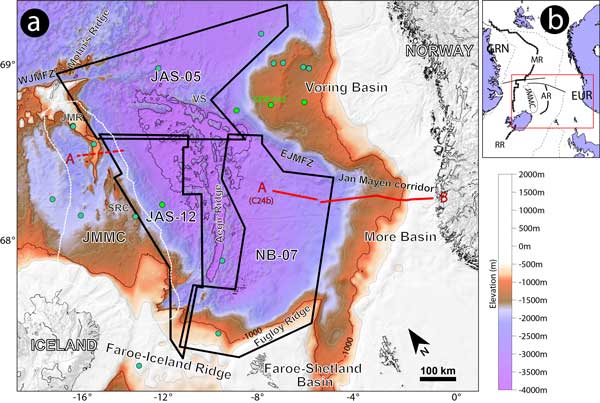
Figure 1: a) Main physiographic features of the Norway Bain and surrounding conjugate margins. The black polygons (JAS-05, NB-07 and JAS-12) represent the outlines of the new aeromagnetic surveys, acquired between 2005 and 2012 between the Faroe-Shetland, Møre and Vøring margin segments and the conjugate Jan Mayen “microcontinent” (JMMC). EJMFZ: East Jan Mayen Fracture Zone; JMR: Jan Mayen Ridge; SRC: (Jan Mayen) Southern Ridge Complex. b) Outline and location of the main plate boundaries in the Norwegian-Greenland Sea. AR: extinct Aegir Ridge; EUR: Eurasia; GRN: Greenland; MR: Mohns Ridge; RR: Reykjanes Ridge. Click here or on Figure for enlargement.
The need for new, accurate aeromagnetic data
Except for a previous survey that focused on the extinct Aegir Ridge [Jung & Vogt, 1997], the sparse distribution and poor quality of the vintage existing magnetic profiles in the remaining part of the NB (line spacing >30-50 km) was a serious and primary impediment for accurate interpretations of the spreading history between the MVRM and the JMMC (Olesen et al., 2010, Gernigon et al., 2012). Consequently, new surveys were needed in the NB to test, validate and/or discuss controversial tectonic models about JMMC evolution [e.g., Scott et al., 2005; Gaina et al., 2009]. The acquisition and processing of new aeromagnetic surveys (Figures 1 and 2) was then carried out by the Continental Shelf Geophysics group at NGU during the summers of 2009 to 2012. The spreading system and adjacent continent-ocean transitions of the NB are now fully covered by high-quality and high-resolution magnetic data (Figure 2).
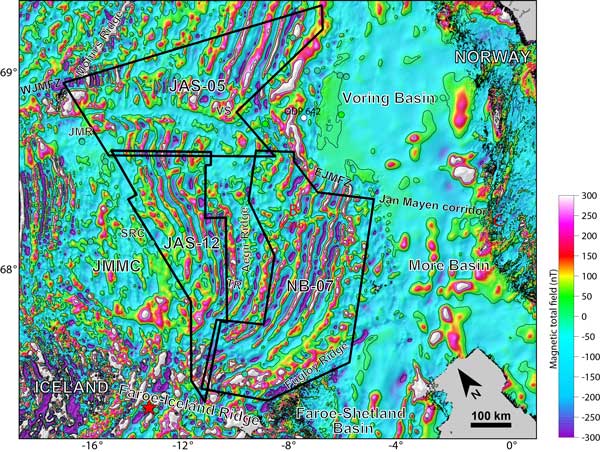
Figure 2: New magnetic total field gridded data for the NB and surrounding areas (after Gernigon et al., 2015). The resulting compilation for the entire NB includes a total of 88,600 km of new, high-resolution aeromagnetic profile data that were merged with the pre-existing magnetic dataset. Click here or on Figure for enlargement.
Pre-breakup and breakup stage
Before the first breakup event in the Early Eocene, the proto-JMMC was tied to the MVRM and the East Greenland margin. It was then part of a complex system of sedimentary basins and poly-phased rift systems that developed in the NE Atlantic [Doré et al., 1999; Skogseid et al., 2000; Tsikalas et al., 2012]. Large uncertainties still remain about the thickness, nature of the crust expected beneath the Møre sedimentary basin, and the mode of deformation that preceded the spreading stage between the MVRM and the JMMC (Figure 3). We interpret the outer part of the MVRM as the remnant of a continental marginal plateau with preserved (?Meso-Paleozoic) terraces lying on the northern extension of the Fugløy Ridge/Faeroe block, which shows thicker continental crust preserved at the edge of the volcanic margin [White et al., 2008]. In terms of timing, the breakup and opening of the NB is Early Tertiary in age and does not necessarily represent the ultimate stage of continuous and severe crustal and lithospheric deformation that initiated in the Late Jurassic. A renewed phase of extension and normal faulting occurred during the latest Cretaceous and Paleocene in the outer part of the pre-existing rift. It preceded a magmatic-tectonic thinning event concomitant with the volcanic margin and Seaward Dipping Reflector (SDRS) development in the Latest-Paleocene-Early Eocene. This late episode may have involved independent and decoupled magmatic-tectonic processes including massive crustal dilatation by diking and crustal plumbing [e.g. Klausen & Larsen, 2002; Geoffroy et al., 2005] and/or magmatic rift localization triggered and/or pulsing with nascent underplating [e.g., Callot et al., 2001; Yamasaki & Gernigon, 2009].
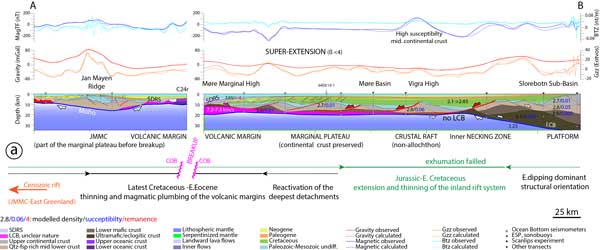
Figure 3: a) Conjugate volcanic rifted sections between the MVRM and the JMMC (section located in Figure 1). Click here or on Figure for enlargement.
Spreading evolution
The new magnetic compilation illustrates new oceanic features and documents in detail the magnetic polarity chrons of the NB (Figure 2). The new aeromagnetic compilation confirms, in particular, that fan-shaped spreading of the NB was clearly active after breakup and before the cessation of seafloor spreading and extinction of the Aegir Ridge in Early Oligocene time (~22 My ago). Faster spreading rates (Figure 4) are recorded in the northern part of the NB and slower spreading rates near the Faeroes-Iceland Ridge which is located closer to the main set of rotation poles of the NB. The degree of melting is not directly related to any linear spreading rate development. Melt production is more dominant in the southern NB closer to the Faeroes-Iceland Ridge. A similar situation might be expected during development of the volcanic margins and SDRs.
The new magnetic data compilation shows also that accretion developed faster on the eastern side of the NB (Figure 4). Both a differential spreading rate and episodic ridge jumps may explain the spreading asymmetry. Even if large uncertainties remain about pre-C24B magnetic chron picking (embryonic volcanic plugs at C25 have been locally interpreted), we have recorded locally low spreading rates during the proto-breakup stage (<5-10 mm/year), increasing suddenly and rapidly after breakup to more than 15-25 mm/year in the early stage of spreading (Figure 4).
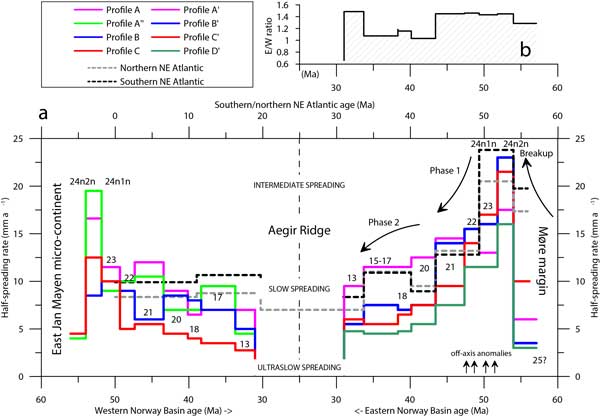
Figure 4: a) Diagram showing the variation with time of the NB spreading system. Average spreading rates for the adjacent northern and southern NE Atlantic oceanic domain (grey and black dashed lines) from Gaina et al. (2009) are plotted for comparison. b) Plot of the spreading-rate ratio between the eastern and western parts of the Norway Basin. The diagram illustrates the general asymmetry of the Norway Basin with higher rates observed in the eastern side of the spreading system. Click here or on Figure for enlargement.
New oceanic fracture zones have been mapped. Some of them initiated at breakup time and some formed later in the Eocene. The JMMC was not entirely rigid during spreading of the Norway Basin, but also experienced significant stretching that increased from north to south during the fan-shaped-spreading development of the NB [e.g., Gaina et al., 2009]. The northern and southern parts of the NB in particular are divided by an important, small-offset fracture zone which appears quite different from the straight and classic appearance of a ‘normal’ fracture zone (Figure 2). This discontinuity shows a complex magnetic pattern characterized by discrete, non-continuous and oblique magnetic lows and highs interpreted as a kind of oceanic ‘pseudo fault’ that linked two separate oceanic spreading systems in the NB. The two segments and the ‘pseudo fault’ are the direct consequence of the distinct time and space development of (at least) two sub-plates bordered by the Jan Mayen Ridge and South Jan Mayen Ridge Complex (Figure 1).
“Microcontinent” formation
Despite a recent refraction survey north of Iceland [Brandstottir et al., 2015], it remains difficult to identify clearly and fully understand the nature of the crust between the Aegir and Kolbeinsey Ridges. Taking into consideration the previous proto-JMMC space issue at breakup time (Figure 5), we infer that more than 400% of post-breakup extension must have occurred in the southernmost part of the JMMC. In this context, the traditional term 'microcontinent' [Scrutton et al., 1976] might be inappropriate for a large part of this feature, where the integrity and preservation of massive continental units might have been seriously disrupted by distributed oceanic accretion even before the complete formation of the Kolbeinsey Ridge.
The northern part of the JMMC was originally located west of the MVRM in the vicinity of the Vøring transform margin (Figures 3 and 5). Our refined, pre-breakup plate reconstruction suggests that the central and northern parts of the proto-JMMC could have been accommodated in the remaining space available between the Norwegian and Greenland continental plates at almost breakup time (Figure 5). However, the southern part of the JMMC, as observed at the present day, could not fit in the space available between Norway/Eurasia and Greenland. Whatever the nature of the crust in the southern JMMC is (continental, oceanic?), this plate overlapping issue confirms that younger and significant deformation affected the JMMC after the first phase of breakup in the Norwegian-Greenland Sea, but before the final dislocation of the JMMC and opening of the Kolbeinsey Ridge at around C6b (22.2-21.7 Ma) time [Vogt et al., 1980; Gaina et al., 2009].
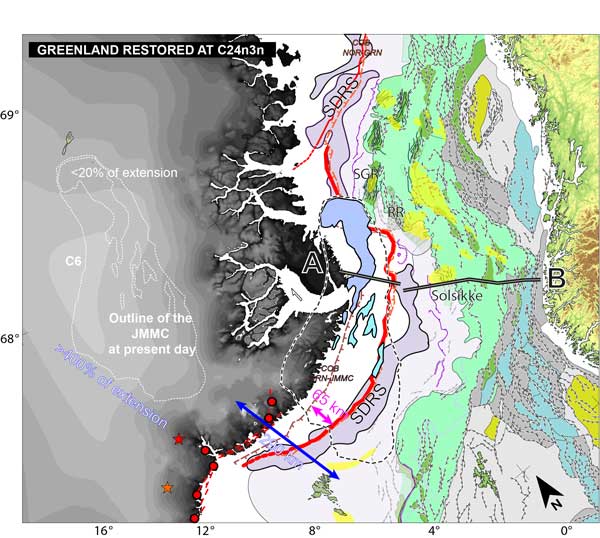
Figure 5: Reconstruction for magnetic chron C24n3n time showing tectonic features discussed in this study. The main physiographic elements (undeformed) and the outline of the JMMC, as defined by the oldest magnetic anomalies recognized at present day, were restored slightly after the first phase of breakup between the Norwegian and Greenland plates. A significant overlap exists between the present-day outline of the JMMC and the original space allocated and available between Greenland and the Møre volcanic rifted margin at magnetic chron C24n3n (~54 Ma). This overlap is mainly explained by the Cenozoic and significant post-breakup (continental and oceanic) extension expected south of the JMMC before chron C6b (initiation of the second breakup phase between proto-JMMC and Greenland). Location of the coast-parallel dike complexes (61-47 Ma, red dashed lines) and main intrusions onshore Greenland (red circles) from Klausen and Larsen (2002), Tegner et al. (1998) and Larsen et al. (2013). Click here or on Figure for enlargement.
Our preferred spreading scenario suggests that the period of fan-shaped growth of the NB developed particularly after chron C21r (48.5-47.3 Ma), where a clear spreading reorganisation was highlighted by the new aeromagnetic survey (Figure 6). A counter-balanced extension in the southern part of the proto-JMMC then grew rapidly and reciprocally precisely at that stage. This phase may coincide with the climax of rift deformation in the southern JMMC and was probably coeval with the onset of compression/transpression observed along the eastern flank of the JMMC (Gunnarson et al., 1989). The C21 event also corresponds well to recent 40Ar-39Ar age re-evaluations of the regional, coast-parallel dike swarm along the Bosseville Kyst at around 49-44 Ma (Larsen et al., 2013) and several tectono-stratigraphic changes observed in the adjacent sedimentary basins (Gernigon et al., 2012).
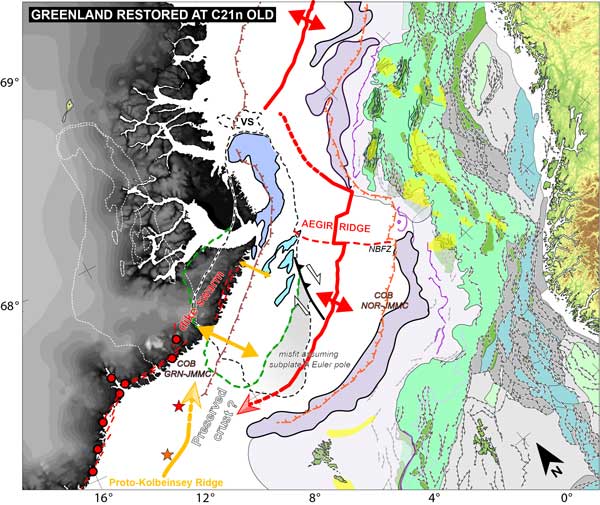
Figure 6: Reconstruction at C21n time (old edge ~47.9 Ma) showing tectonic features and continental fragments involved in this study. This Mid-Late Eocene event coincides with an important phase of reorganization in the NB. Chron C21n marks the onset of serious extension in the southern JMMC in order to counter-balance the subsequent growth and fan-shaped development of the NB spreading system. This period should coincide with the onset of extension between East Greenland and the proto-JMMC in front of the propagating Reykjanes Ridge located to the south. The main physiographic elements of the JMMC (undeformed) have been restored at that stage based on the two sets of rotation poles defined between the JMMC and the Norwegian plate (fixed). Click here or on Figure for enlargement.
Finally, the origin and location of this rift leading to the second phase of breakup and final isolation of the ambiguous JMMC are still questionable. The action of a mantle plume, by 'thermal weakening' was proposed earlier to explain microcontinent formation (Müller et al., 2001). However, in our opinion, complex rift/ridge overlap and a dual rift system geometry between the dying Aegir Ridge and nascent Kolbeinsey Ridge was probably the main process initiating the formation of the microcontinent. Natural rift overlapping can easily explain early insolation and formation of the microplate without involving any mantle plume (e.g., Auzende et al., 1980; Koehn et al., 2007). Progressive rift migration towards a plume axis is also debatable (see http://www.mantleplumes.org/Iceland4.html). A rift overlap could have been favored by the initial crustal configuration and the presence of inherited crustal "buffers" such as the Faeroes block and possibly similar continental terranes thought to underlie Iceland (see http://www.mantleplumes.org/Iceland4.html). Such model would also involve a preserved but intensely intruded zone of continental residue between the Aegir and the Reykjanes ridges, which never really fully connected in such a scenario (Figure 6). More questionable remains, however, the final insulation stage of the JMMC. It was preceded by propagating magmatic and diking events that initiated (at least) 7-8 Myr before the establishment of a stable oceanic accretion system between the JMMC and East Greenland (Larsen et al., 2013). Therefore, the origin and tectonic implication of magmatism (related or not to a hypothetical mantle plume; Foulger & Anderson, 2005) cannot be neglected and probably contribute to the breakup and indirectly to microcontinent formation.
References
-
Auzende, J. M., P. Beuzart, J. Bonnin, J. L. Olivet, B. Sichler, and P. Unternehr (1980), Mode de dislocation des continents lors des stades initiaux d´ouverture, paper presented at 8éme Réunion des Sciences de la Terre de la Société Géologique de France.
-
Blischke, A., T. S. Arnarson, and K. Gunnarsson (2011), The Structural History of the Jan Mayen Microcontinent Micro-continent (JMMC) and Its Role During the Rift “Jump” Between the Aegir to the Kolbeinsey Ridge, paper presented at AAPG, 3P Arctic - The Polar Petroleum Potential Conference & Exhibition, AAPG, Halifax, Nova Scotia, Canada.
-
Brandsdottir, B., E. E. E. Hooft, R. Mjelde, and Y. Murai (2015), Origin and evolution of the Kolbeinsey Ridge and Iceland Plateau, N-Atlantic, Geochem. Geophy. Geosy., 16(3), 612-634.
-
Breivik, A. J., R. Mjelde, J. I. Faleide, and Y. Murai (2012), The eastern Jan Mayen microcontinent volcanic margin, Geophys. J. Int., 188(3), 798-818.
-
Callot, J. P., C. Grigné, L. Geoffroy, and J. P. Brun (2001), Development of volcanic passive margins: Two-dimensional laboratory models, Tectonics, 20(1), 148-159.
-
Ebinger, C. J., and M. Casey (2001), Continental breakup in magmatic provinces: An Ethiopian example, Geology, 29(6), 527-530.
-
Eldholm, O., J. Thiede, and B. Taylor (1989), Evolution of the Vøring volcanic margin, in Proceedings of the Ocean Drilling Program, Scientific Results, Vol. 104, edited by O. Eldholm, J. Thiede and E. Taylor, pp. 1033-1065, College Station, TX (Ocean Drilling Program).
-
-
Gaina, C., L. Gernigon, and P.J. Ball (2009), Palaeocene-Recent plate boundaries in the NE Atlantic and the formation of the Jan Mayen microcontinent, J. Geol. Soc. London, 166, 601-616.
-
Geoffroy, L. (2005), Volcanic passive margins, Cr. Geosci., 337(16), 1395-1408.
-
Gernigon, L., A. Blischke, A. Nasuti, and M. Sand (2015), Conjugate volcanic rifted margins, seafloor spreading, and microcontinent: Insights from new high-resolution aeromagnetic surveys in the Norway Basin, Tectonics, 34(5), 907-933.
-
Gernigon, L., C. Gaina, O. Olesen, P. J. Ball, G. Peron-Pinvidic, and T. Yamasaki (2012), The Norway Basin revisited: From continental breakup to spreading ridge extinction, Mar. Petrol. Geol., 35(1), 1-19.
-
Guðlaugsson, S. T., K. Gunnarsson, M. Sand, and J. Skogseid (1988), Tectonic and volcanic events at the Jan Mayen Ridge microcontinent, in Early Tertiary Volcanism and the Opening of the NE Atlantic, edited by A. C. Morton and L. M. Parson, pp. 85-93, Geological Society, Special Publications 39.
-
Jung, W. Y., and P. R. Vogt (1997), A gravity and magnetic anomaly study of the extinct Aegir Ridge, Norwegian Sea, J. Geophys. Res., 12(B3), 5065-5089.
-
Kandilarov, A., R. Mjelde, R. B. Pedersen, B. Hellevang, C. Papenberg, C. J. Petersen, L. Planert, and E. Flueh (2012), The northern boundary of the Jan Mayen microcontinent, North Atlantic determined from ocean bottom seismic, multichannel seismic, and gravity data, Mar. Geophys. Res., 33(1), 55-76.
-
Klausen, M. B., and H. C. Larsen (2002), East Greenland coast-parallel dike swarm and its role in continental breakup, in Volcanic rifted margins, edited by M. A. Menzies, S. L. Klemperer, C. J. Ebinger and J. Baker, pp. 133-158, Geological Society of America Special Paper, Boulder Colorado.
-
Kodaira, S., R. Mjelde, K. Gunnarsson, H. Shiobara, and H. Shimamura (1998), Structure of the Jan Mayen microcontinent and implications for its evolution, Geophys. J. Int., 132(2), 383-400.
-
Larsen, L. M., A. K. Pedersen, E. V. Søorensen, W. S. Watt, and R. A. Duncan (2013), Stratigraphy and age of the Eocene Igtertiva Formation basalts, alkaline pebbles and sediments of the Kap Dalton Group in the graben at Kap Dalton, East Greenland, Bull. Geol. Soc. Denmark, 61, 1-18.
-
Mjelde, R., I. Eckhoff, S. Solbakken, S. Kodaira, H. Shimamura, K. Gunnarsson, A. Nakanishi, and H. Shiobara (2007), Gravity and S-wave modelling across the Jan Mayen Ridge, North Atlantic; implications for crustal lithology, Mar. Geophys. Res., 28(1), 27-41.
-
Müller, R. D., C. Gaina, W. R. Roest, and D. L. Hansen (2001), A recipe for microcontinent formation, Geology, 29(3), 203-206.
Nunns, A. G. (1983), Plate tectonic evolution of the Greenland-Scotland Ridge and surrounding regions, in Structure and Development of the Greenland-Scotland Ridge, edited by M. H. P. Bott, S. Saxov, M. Talwani and J. Thiede, pp. 1-30, Plenum Press, New York, New York.
-
Olesen, et al. (2010), New aeromagnetic and gravity compilations from Norway and adjacent areas - methods and applications, in Petroleum Geology: From mature basins to new frontiers, Proceedings of the 7th Petroleum Geology Conference, edited by B. A. Vining and S. C. Pickering, pp. 559-586, Geological Society of London
-
Scott, R. A., L. A. Ramsey, S. M. Jones, S. Sinclair, and C. S. Pickles (2005), Development of the Jan Mayen microcontinent by linked propagation and retreat of spreading ridges, in Onshore-Offshore relationships on the North Atlantic Margin, edited by B. T. G. Wandås, J. P. Nystuen, E. Eide and F. Gradstein, pp. 69-82, Norwegian Petroleum Society (NPF), Special Publication.
-
Scruton, R. A. (1976), Microcontinents and their significance, in Geodynamics Progress and Prospects, edited by C. L. Drake, pp. 177-189, AGU, Washington, D.C.
-
Skogseid, J., and O. Eldholm (1987), Early Cenozoic crust at the Norwegian continental margin and the conjugate Jan Mayen Ridge, J. Geophys. Res., 92, 11471-11491.
-
Tegner, C., C. K. Brooks, R. A. Duncan, L. E. Heister, and S. Bernstein (2008), Ar-40-Ar-39 ages of intrusions in East Greenland: Rift-to-drift transition over the Iceland hotspot, Lithos, 101(3-4), 480-500.
-
Tsikalas, F., J. I. Faleide, O. Eldholm, and O. A. Blaich (2012), The NE Atlantic conjugate margins, in Phanerozoic Passive Margins, Cratonic Basins and Global Tectonic Maps, edited by D. G. Roberts and A. W. Bally, pp. 141-201.
-
Unternehr, P. (1982), Etude structurale et cinématique de la mer de Norvège et du Groenland - Evolution du microcontinent de Jan Mayen, Ph.D. thesis, 228 pp, Université de Bretagne Occidentale (UBO), Brest.
-
Vogt, P. R., G. L. Johnson, and L. Kristjansson (1980), Morphology and Magnetic Anomalies North of Iceland, J. Geophys., 47, 67-80.
-
White, R. S., L. K. Smith, A. W. Roberts, P. A. F. Christie, N. J. Kuznir, and iSIMM Team (2008), Lower-crustal intrusion on the North Atlantic continental margin, Nature, 452(27), 460-464.
-
Yamasaki, T., and Gernigon, L. (2010), Redistribution of the lithosphere deformation by the emplacement of underplated mafic bodies: implications for microcontinent formation, J. Geol. Soc., 167, 961-971.
last updated 21st August, 2015 |
